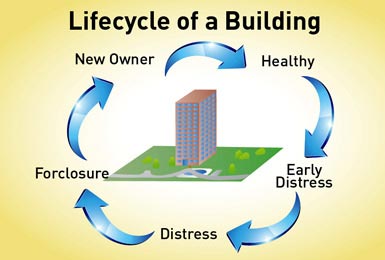When to Take Advantage of a Distressed Building by Restructuring Your Lease
Underperforming buildings often provide tenants with the opportunity to obtain more favorable lease terms from their landlords.
Directory 2013

Phase I: Early stage of financial stress — During this phase, a building transitions from generating enough cash in order to meet operating and debt service obligations to one that is struggling financially. The owner is in the early stages of awareness that trouble is on the horizon, but may still be counting on a loan modification or the local real estate market to bail him out. Characteristics of buildings in this stage include increasing vacancy, reduced leasing velocity, a change in leasing agents, visible and creative marketing strategies, reduced (or no) dollars available for tenant improvements, or obvious deferred maintenance. Unless the organization you represent is of sufficient size to have a material impact on the building, it is unlikely that this is the right time to approach the owner about a lease revision. The owner has yet to fully accept the realities of the current marketplace.
Phase II: Established underperformance — During this phase, it becomes clear that a building has financial issues. The signs are no different than the previous phase, just more noticeable and more public. The bank has begun to take an active interest and is putting pressure on the owner to get current on debt service and to look for alternative financing. This phase is a good time to restructure a lease. The owner is interested in buying time with the bank and increasing long-term cash flow. He still has enough control of the building to make unilateral decisions and could be open to exploring alternatives that support a long-term workout strategy that keeps the building out of the hands of the creditors. The owner's primary goal is to avoid moving to the next phase of the lifecycle.
Phase III: Foreclosure negotiations — Unless your organization's tenancy is large or lucrative enough to materially impact an asset's financial performance, the timeframe during which foreclosure discussions are ongoing is generally not a good time to try to renegotiate terms. The landlord, while still technically owner of the property, has lost the ability to operate unilaterally and the bank is not motivated to do anything that slows down the achievement of their ultimate goal, to gain possession of the building. In addition, in today's modern financial environment, many buildings have multiple layers of structured debt (and equity). Because of the increased number of decision-makers, decision-making is difficult and prolonged and receptivity to lease modifications is muted.
Phase IV: Change in ownership — Once a lending institution takes back an asset, there is an initial period when very little happens. The special assets workout team has to fully understand a property and the market within which it operates and develop an asset management and disposition strategy. During these initial stages of institutional ownership, it's unlikely that proposed lease modifications will get much attention. However, once an asset management plan is in place, any proposal that can help the financial institution meet its objectives of reducing costs and maximizing its recovery will be positively received. Having insight about what the lender, now owner, is trying to achieve is of critical importance in establishing a successful negotiation.
Phase V: Building is sold to a new owner — This is the final stage of the cycle; the financial institution or distressed owner sells the building. The building's basis is reset and the return expectations of new ownership are more in line with current market realities. The building has been underwritten to reflect current market conditions and the underlying debt and equity ownership structure has been rationalized; new capital may now be available for improvements and financing other concessions. Establishing a relationship with the new owner is a critical step in a mutually beneficial long-term relationship.
Healthy building - Although increasingly rare in today's environment, another category of building exists — one that is in strong financial condition. Regardless of appearance, many of these buildings are only one large bankrupt tenant from entering into the distress, foreclosure, sale, and revitalization process described above. We believe it's important to track activities at these buildings as diligently as at underperforming assets. Early knowledge of potential issues can provide useful leverage in a (re)negotiation by a tenant.
Real estate professional services firms with strong offices in key markets and offering good research information represent the best source of market- and building-level data needed to support proactive portfolio planning and strategy. Regardless of whether your organization's real estate is outsourced, out-tasked, in-house, or a hybrid, we believe the best approach is to define needs and pass the execution responsibility on to someone with the requisite local market knowledge.
This article was extracted from a piece that originally appeared in the November 2010 issue of the Corporate Real Estate Journal produced by Henry Stewart Publications
Project Announcements
Australia-Based Aquatic Leisure Technologies Group Plans Opp, Alabama, Manufacturing Operations
12/11/2025
Teradyne Plans Wixom, Michigan, Robotics Operations
12/11/2025
Robinson Plans Altoona, Iowa, Manufacturing Operations
12/11/2025
BioTouch Expands Columbus, Georgia, Operations
12/11/2025
Natrion Plans Erie County, New York, Battery Components Operations
12/11/2025
Czech-Based GZ PrintPak Expands Mount Pleasant, Wisconsin, Manufacturing Operations
12/11/2025
Most Read
-
The Workforce Bottleneck in America’s Manufacturing Revival
Q4 2025
-
Rethinking Local Governments Through Consolidation and Choice
Q3 2025
-
Lead with Facts, Land the Deal
Q3 2025
-
How Canada Stays Competitive
Q3 2025
-
Investors Seek Shelter in Food-Focused Real Estate
Q3 2025
-
America’s Aerospace Reboot
Q3 2025
-
The Permit Puzzle and the Path to Groundbreaking
Q3 2025